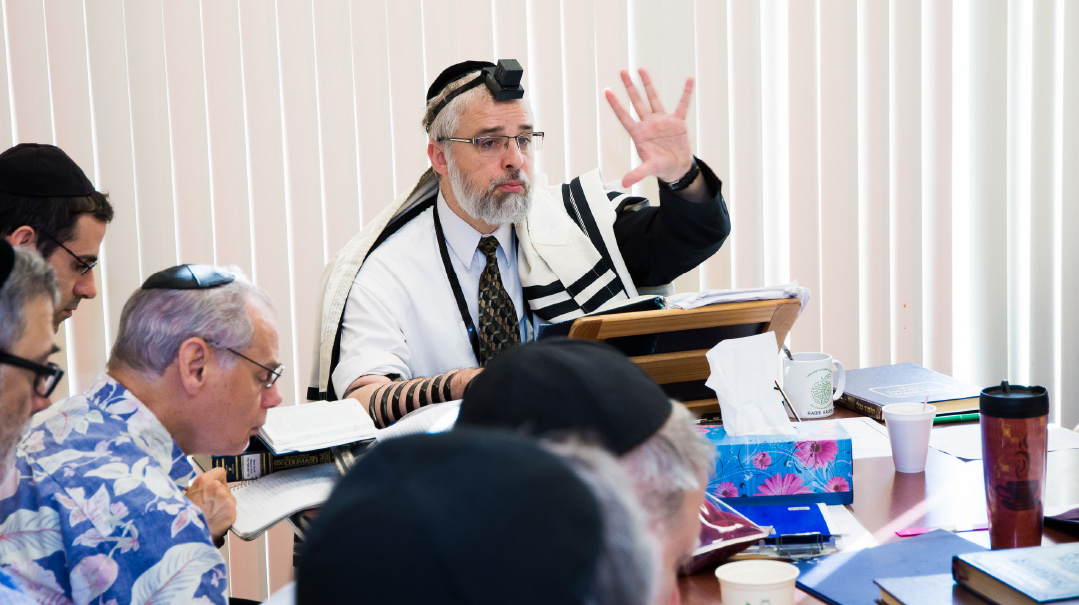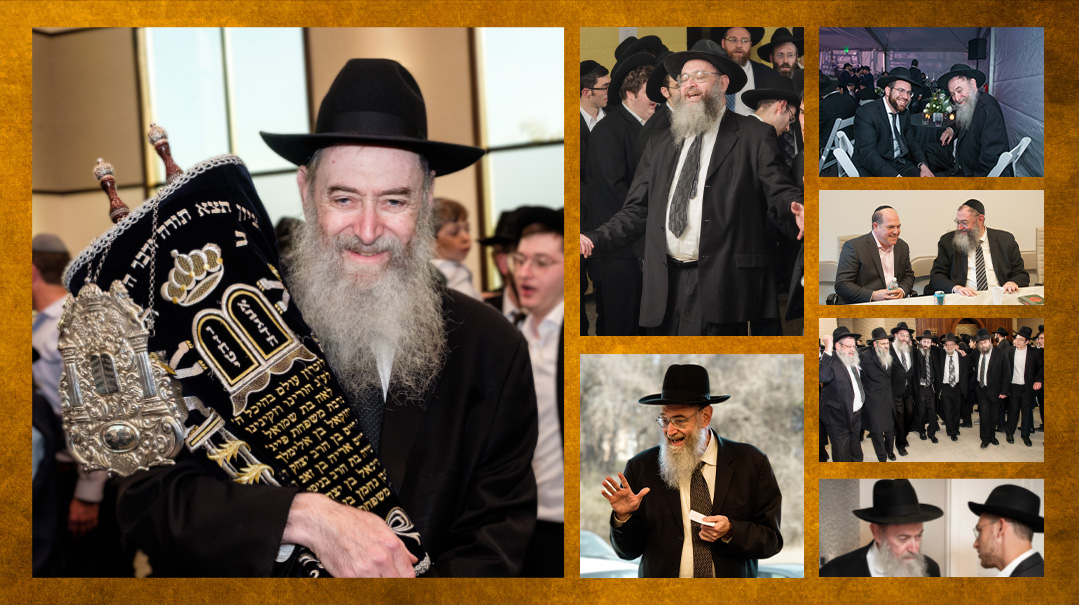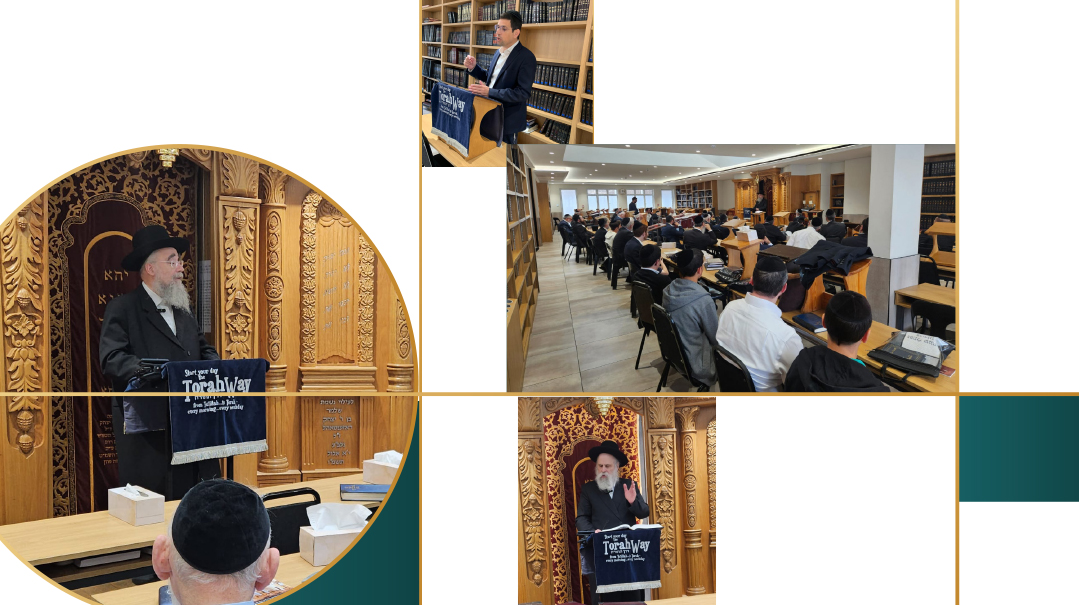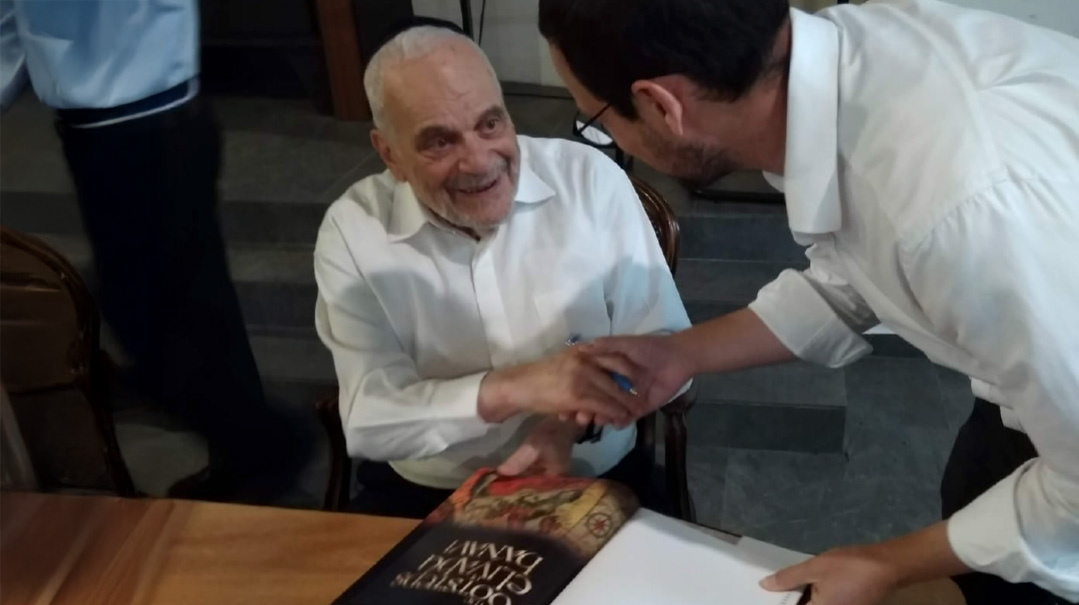Shabbos Souls
| April 22, 2025The tragic loss of Mrs. Sara Natasha Saada and her daughters Dina Bracha (Diana) and Devorah Mazal (Debra)

The Lelover Rebbe at the Saada house several years ago, in honor of a kesivas sefer Torah
During the coming week, the community will mark 30 days since the tragic loss of Mrs. Sara Natasha Saada and her daughters Dina Bracha (Diana) and Devorah Mazal (Debra). The following was composed by the Lelover Rebbe of Boro Park, with whom the family had a close kesher, in honor of the niftaros and yblch”t Mr. Tzadka Yehoshua (Sidney) Saada.
T
he Saada family home was one of Torah, gemilus chasadim, and exceptional varemkeit (warmth) for Yiddishkeit.
Mrs. Sara Natasha Saada built and fortified her home with unique wisdom, and infused it with simchah and kedushah. She and her family were always yearning, thirsting for more Torah, more kedushah, more ruchniyus.
Mrs. Saada instituted learning at the table during Friday night seudos. The family studied hilchos Shabbos and the sefer Bas Ayin.
Mrs. Sara Natasha took great pride in the Torah learning of all her children. At the Shabbos morning seudah, just before they left to visit grandparents (which sadly led to the accident), the whole family sang Mah Nishtanah together, so the children could practice it. She wanted them to know it well, as she did for all their learning and avodas Hashem.
She greatly valued, respected, and encouraged her husband’s learning. When he would return home from a shiur given by the family rav, Rav Yosef Ozeri, or others, she always asked about the limudim. Whether it was the laws of ribbis or chullin, she hut mitgelebt his learning Torah — she made it a focus of her life.
T
he Saadas were drawn to Jews who embodied the warmth and love of Yiddishkeit, vareme Yidden. Whenever they found such people, they would gravitate toward them, wanting to get ever closer to them, to bask in their light and guidance. This characterizes the kind of people the Saada family are.
When it was time to select a suitable cheder for their son Refael Pinchas, Mrs. Saada searched for a yeshivah that would provide not only a quality Torah education, but that would instill love, devotion, and varemkeit for Yiddishkeit. Only an institution like that would be in sync with and similar to the atmosphere she had created in her home.
In recent years, the Saada family has become very gebinden, connected, to Eretz Yisrael. They visited often, spent Succos there the last few years, and hosted a Simchas Beis Hashoeivah together with Reb Meilech Biderman, the Rebbe’s brother. Mr. Saada is close with the Lutzker Rebbe, who advised him to learn Mishnayos Maseches Terumos. After he completed it, the Rebbe advised him to take on Parah.
Mrs. Saada had a special connection to Shabbos. When the Rebbe visited Tzadka Yehoshua at the shivah, he mentioned that she stood over the Shabbos lecht every Friday night for over 40 minutes after her husband had gone to shul, davening with tears in her eyes.
She baked challos for Shabbos with her daughters every Thursday, and cried in tefillah during hafrashas challah. One of the girls’ teachers mentioned that Mrs. Saada had advised her to cry and pray for her children during the special eis ratzon of hafrashas challah. Diana came to school late one Thursday, with a note explaining that she had wanted to stay and daven with her mother a little bit longer than usual while baking the challos for Shabbos.
Every week, the girls brought two fresh challos to an elderly woman who lived next door. Mrs. Saada would instruct them to spend extra time with the woman, making her feel like she was their honorary grandmother.
As a youngster, Sara Natasha took it upon herself to prepare her parents’ home for Shabbos. They owned and operated the only kosher restaurant in their neighborhood in London, and customers would frequent the store until very close to the zeman of Shabbos. Sara Natasha committed to make sure her parents could finish a stress-free day of work by coming home to a stress-free Erev Shabbos environment.
T
he Saada family prioritized tzedakah and chesed. Several kesivos sifrei Torah took place in the home, and another was scheduled to occur in several weeks. They sponsored Torah, talmidei chachamim, and published seforim, assisting financially with the publication of Reb Meir Zev Trepp’s seforim on Shulchan Aruch.
Before Shabbos, Sidney (Tzadka Yehoshua) Saada made an urgent call to the Rebbe. He had remembered that he had pledged $1,300 to Mrs. Ovadia, a widowed woman living in Rechasim, Eretz Yisrael, but had not succeed in contacting her to complete the donation due to some technical difficulties with the phone and bank transfer system. He traveled to the Rebbe’s home, and, while sitting with the Rebbe, Tzadka Yehoshua tried the widow again. This time he was successful, and he immediately transferred the money.
Mrs. Ovadia was overjoyed, and thanked Tzadka Yehoshua profusely. “I had just returned from my late husband’s seudas yahrtzeit,” she explained. “I was feeling really down and lost after marking his petirah, but you have restored me to life.”
Mrs. Saada always emphasized to her children the importance of hakaras hatov and giving to others. Her sister reported that she would often buy things for others — things she would not fargin herself. When her sister asked about this practice, Mrs. Saada explained, “It’s not my money, it’s Hashem’s money.” She did not feel that she had a right to purchase these items for herself, but for others it was okay.
Sara Natasha had earned a graduate degree in psychology and criminal law while living in London as a single woman. When she married and moved to America, she abandoned her prestigious career opportunities and took a position as a morah for young children. Once she had her own children, she said it was her duty to be a mother, and so she was. A neighbor related how she would board the school bus with her children and buckle their seatbelts with so much warmth and love… as well as those of any other children who were not properly secured.
She was a kallah teacher, and would often guide young brides in the ways of vatranus and benevolence. “Do you want to be right?” she would ask. “Or would you rather be happy?”
Once, Mrs. Saada gently pointed out to her children that they had so much, and other children were not as lucky. She suggested to the children to choose their three favorite toys and donate the rest to Chai Lifeline, where they would bring happiness to children battling illness.
The children agreed, and they did so. But Mrs. Saada wanted to make sure they were happy with the mitzvah they had done, and felt pride, not resentment. She phoned their school principal and teacher to tell them about the huge mitzvah they had done and their huge sacrifice. The staff composed a beautiful “mitzvah note” congratulating the children and complimenting them on their achievement.
T
he Rebbe often said that the girls, Diana Bracha and Deborah Mazal, were “heilige Shabbosdige neshamos.” They were fine little girls, so sensitive to the mitzvah of tzniyus.
Diana took gymnastics classes, until one day, she returned home from the class and told her parents that she didn’t want to go back. When questioned as to the reason for the sudden change, the young girl responded, “There are other people [non-Jews] there, it’s not tzniyus… I don’t want to go anymore.”
Deborah had been reading books about tzaddikim, and read a story one day teaching the middah of emet. Later, she approached her parents and shyly admitted that sometimes, when she got very hot, she might take her over-shirt off. “And that’s not good!” she concluded.
The children’s playroom features hand-painted tambourines, ready to play when Mashiach arrives at any moment. This is a fulfillment of the minhag to have the musical instruments on hand, as part of the mitzvah of tzipiah l’yeshuah, hoping for and having faith in the coming redemption. It is emulating the way of Miriam Haneviah, who left Mitzrayim with a tambourine, steadfast in the faith that Klal Yisrael would soon sing shirah to Hashem.
The Rebbe explained, conceptually, that some “pure and holy souls, children who have not tasted sin, are souls that take it upon themselves to come down to this world, to protect Klal Yisrael, and to serve as a kapparah for the klal.”
May the heilige neshamos of the niftaros be meilitz yosher for Klal Yisrael, and hasten the coming of Mashiach, so we may sing shirah together again, with those tambourines in hand.
Yehi zichran baruch.
(Originally featured in Mishpacha, Issue 1058)
Oops! We could not locate your form.







